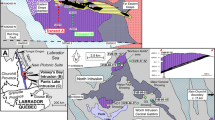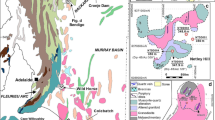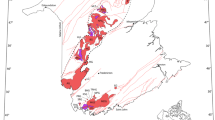Summary
At Climax, comagmatic igneous intrusions can be subdivided into two groups, mineralizing stocks which are parent intrusions for Mo orebodies and barren stocks. Magmatic biotites in mineralizing stocks are similar to hydrothermal biotites in that they contain a greater proportion of Si-enriched and Ti-depleted compositional domains than do magmatic biotites in barren stocks. A similar trend of Si-enrichment correlated with Ti-depletion is also recorded in biotites from the Bingham porphyry copper deposit. Such trends are attributed to vapour exsolution associated with mineralization. Mo concentrations of magmatic biotites, as determined by ion-probe analysis, from mineralizing stocks (av. 40 gg/g) and barren stocks (av. 33 μ/g) at Climax are similar, being in the same order of magnitude as magmatic biotite Cu concentrations in mineralizing and barren (type A) intrusions in North American porphyry copper deposits (Hendry et al., 1985). These Cu and Mo values are more than a factor of 10 lower than Cu concentrations commonly recorded in magmatic mafic phases in barren (type B) South West Pacific and Australian granitic systems that are temporally distinct from mineralizing events, and are consistent with the magmatic-hydrothermal origin for the Climax deposits proposed by White et al. (1981).
Zusammenfassung
Zwei Gruppen komagmatischer Intrusivkörper können im Bereich der Molybdän-Lagerstätte Climax, Colorado, unterschieden werden: Mineralisierende Intrusiva, die Stammagmen für Molybdän-Erzkörper darstellen, und erzfreie Intrusiva. Magmatische Biotite in mineralisierenden Intrusiva sind hydrothermalen Biotiten insofern ähnlich, als sie einen größeren Anteil von Si-angereicherten und Ti-verarmten Bereichen enthalten als magmatische Biotite in erzfreien Intrusiva. Ein ähnlicher Trend von Si-Anreicherung, die mit Ti-Verarmung korreliert werden kann, ist auch in Biotiten aus der Porphyry-copper-Lagerstätte Bingham bekannt geworden. Derartige Trends werden auf Entmischung von Dampfphasen in Zusammenhang mit der Mineralisation zurückgeführt.
Molybdän-Konzentrationen von magmatischen Biotiten in Climax wurden mit der Ionensonde bestimmt und zeigen in mineralisierenden und erzfreien Intrusiva ähnliche Werte, i.e., 40 p/g bzw. 33 gg/g. Diese Werte liegen in derselben Größenordnung wie Kupferkonzentrationen in magmatischen Biotiten aus vererzten und erzfreien (Typ A) Intrusionen im nordamerikanischen Porphyry-copper-Lagerstätten (Hendry et al., 1985). Diese Kupfer- und Molybdänwerte sind um den Faktor 10 niedriger als Kupferkonzentrationen, die man gewöhnlich in magmatischen mafischen Phasen in erzfreien (Typ B) Granitsystemen im südwestlichen Pazifik und Australien nachgewiesen hat. Diese sind zeitlich einer anderen Entstehungsperiode zuzuordnen als die erzbildenden Vorgänge, und dies stimmt wiederum mit der magmatisch hydrothermalen Entstehung der Lagerstätten von Climax überein, wie sie vonWhite et al. (1981) vorgeschlagen worden ist.
Similar content being viewed by others
References
Arima M, Edgar AD (1981) Substitution mechanisms and solubility of titanium in phlogopites from rocks of probable mantle origin. Contrib Mineral Petrol 77: 288–295
Bowman JR, Parry WT, Kropp WP, Kruer SA (1987) Chemical and isotopic evolution of hydrothermal solutions at Bingham, Utah. Econ Geol 82: 395–428
Candela PA, Holland HD (1984) The partitioning of copper and molybdenum between silicate melts and aqueous fluids. Geochim Cosmochim Acta 48: 373–380
—— (1986) Amass transfer model for copper and molybdenum in magmatic hydrothermal systems: The origin of Porphyry-Type Ore Deposits. Econ Geol 81: 1–19
Chivas AR (1976) Magmatic evolution and porphyry copper mineralization of the Koloula Igneous Complex, Guadalcanal. Int Geol Cong 25th, Sydney, 1: 48
—— (1981) Geochemical evidence for magmatic fluids in porphyry copper mineralization. Part 1. Mafic silicates from the Koloula Igneous Complex. Contrib Mineral Petrol 78: 389–403
Creasey SC (1980) Chronology of intrusion and deposition of porphyry copper ores, GlobeMiami District, Arizona. Econ Geol 75: 830–844
Czamanske JK, Wones DR (1973) Oxidation during magmatic differentiation, Finnmarka Complex, Oslo area, Norway. Part 2. The mafic silicates. J Petrol 14: 349–380
Gunow AJ, Ludington S, Munoz JL (1980) Fluorine in micas from the Henderson deposit, Colorado. Econ Geol 75: 1127–1137
Hendry DAF, Chivas, AR, Reed SJB, Long JVP (1981) Geochemical evidence for magmatic fluids in porphyry copper mineralization. 11. Ion-probe analysis of Cu contents of mafic minerals, Koloula Igneous Complex.Contrib Mineral Petrol 78: 404–412
——, ——Long, JVP, Reed SJB (1985) Chemical differences between minerals from mineralizing and barren intrusions from some North American porphyry copper deposits. Contrib Mineral Petrol 89: 317–329
Jacobs DC, Parry WT (1979) Geochemistry of biotite in the Santa Rita porphyry copper deposit, New Mexico. Econ Geol 74: 860–887
Lanier G, Raab WI, Folsom RB, Cone S (1978) Alteration of equigranular monzonite, Bingham Mining District, Utah. Econ Geol 73: 1270–1286
Le Bel L (1979) Micas magmatiques et hydrothermaux dans l'environnement du porphyre cuprifére de Cerro Verde-Santa Rosa, Pérou. Bull Minéral 102: 35–41
Mason DR (1978) Compositional variations in ferromagnesian minerals from porphyry copper-generating and barren intrusions of the Western Highlands, Papua New Guinea. Econ Geol 73: 878–890
Reed SJB (1975) Electron microprobe analysis. Cambridge Univ Press, London, pp 400
—— (1980) Trace element analysis with the ion-probe. Scanning 3: 119–127
Stein HJ, Hanna JL (1985) Movement and origin of ore fluids in Climax-type systems. Geology 13: 469–474
Wallace SR, Baker RC, Jonson DC, Mackenzie WB (1960) Geology of the Climax molybdenum deposits, a progress report. In:Weimer RJ, Haun JD (eds) Guide to the geology of Colorado. Rocky Mountain Assoc Geologists, Denver, pp 238–252
——,Muncaster NK, Jonson DC, Mackenzie WB, Bookstrom AA, Surface VE (1968) Multiple intrusion and mineralization at Climax, Colorado. In:Ridge JD (ed) Ore deposits of the United States, 1933–1967. Vol. 1. Am Inst Mining Metall Petroleum Engineers, New York, pp 605–640
White WH, Bookstrom AA, Kamilli RJ, Ganster MW, Smith RP, Ranta DE, Steininger RC (1981) Character and origin of Climax-type molybdenum deposits. In:Skinner BJ (ed) Economic Geology 75th Anniversary Volume. Economic Geology Publishing Company, El Paso, pp 270–316
Author information
Authors and Affiliations
Additional information
With 4 Figures
Rights and permissions
About this article
Cite this article
Hendry, D.A.F., Gunow, A.J., Smith, R.P. et al. Chemical differences between minerals from mineralizing and barren intrusions associated with molybdenum mineralization at Climax, Colorado. Mineralogy and Petrology 39, 251–263 (1988). https://doi.org/10.1007/BF01163039
Received:
Accepted:
Issue Date:
DOI: https://doi.org/10.1007/BF01163039




